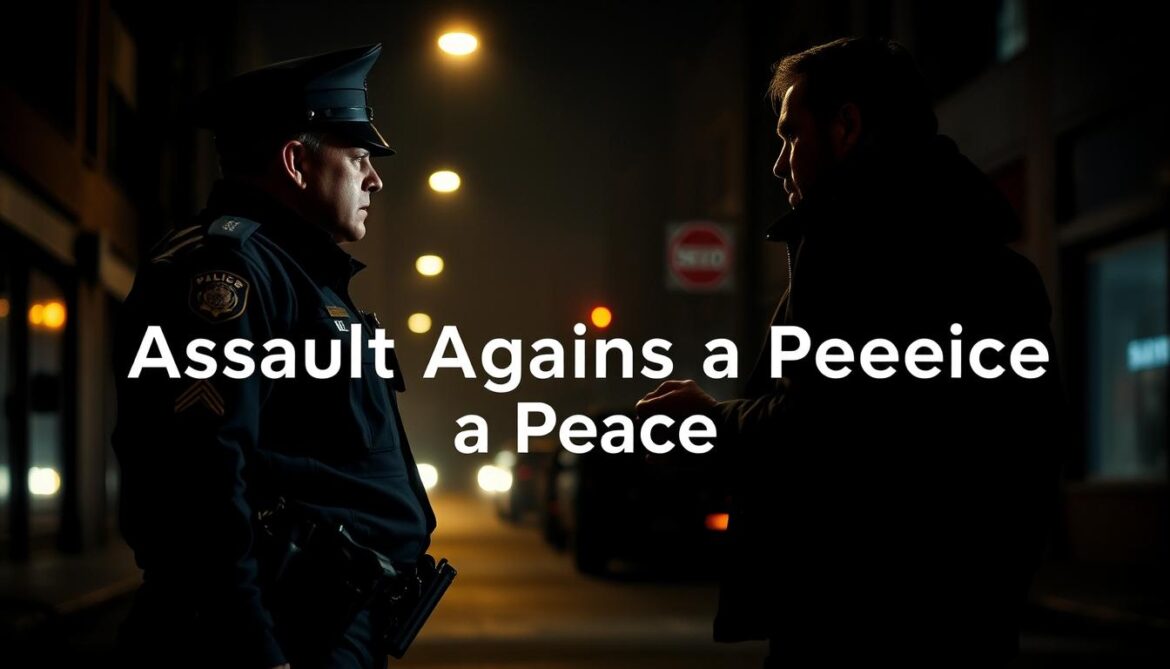Over 10,000 Canadian law enforcement personnel face violent confrontations yearly while on duty. This statistic shows why protection for peace officers is crucial in Canadian criminal law.
Section 270 of the Criminal Code is the key law for these incidents. It deals with actions that threaten peace officer safety and sets clear penalties for offenders.
The Canadian justice system takes these cases seriously. Penalties vary based on how severe the incident is.
This guide explains the law, possible defenses, and recent trends in these cases. You’ll learn how the system protects public servants and ensures fair justice.
Understanding Assault Against a Peace Officer in Canada
Assault charges involving peace officers have specific legal provisions in Canada. These laws protect those who serve in law enforcement. The consequences can be severe, so understanding these statutes is crucial.
Legal Definition Under the Criminal Code
Section 270(1) of the Criminal Code defines assault against a peace officer. It includes assaulting officers during their duties or those aiding them. This creates a distinct category of assault with specific penalties.
The law protects officers performing their duties due to heightened risks. It covers various forms of assault, from minor physical contact to serious attacks. Even threatening gestures or words can qualify under certain circumstances.
Who Qualifies as a “Peace Officer” in Canadian Law
The term “peace officer” includes more than just police officers. Canadian law extends this designation to various law enforcement roles.
- Municipal and provincial police officers
- Royal Canadian Mounted Police (RCMP) members
- Correctional officers and prison guards
- Border services officers
- Conservation officers
- Certain bylaw enforcement officers
This broad definition reflects Canada’s diverse law enforcement landscape. The same legal protections apply to all categories of peace officers. When facing charges, the officer’s specific role will be examined.
Historical Context of the Offense
The special legal status for peace officers has evolved over time in Canadian law. These provisions acknowledge law enforcement’s unique role in maintaining social order.
Canadian legal protections for officers developed from British common law. Current provisions balance officer protection with citizen rights. Courts now carefully examine each case’s circumstances.
This historical context explains the severe treatment of these offenses. It also shows how the interpretation of these laws continues to evolve in modern society.
The Criminal Code Provisions
Canada’s Criminal Code outlines provisions for assaults against peace officers. These laws protect law enforcement personnel. They define offenses, penalties, and related charges for confrontations with peace officers.
These legal frameworks are crucial for citizens and legal professionals. They help navigate cases involving confrontations with peace officers.
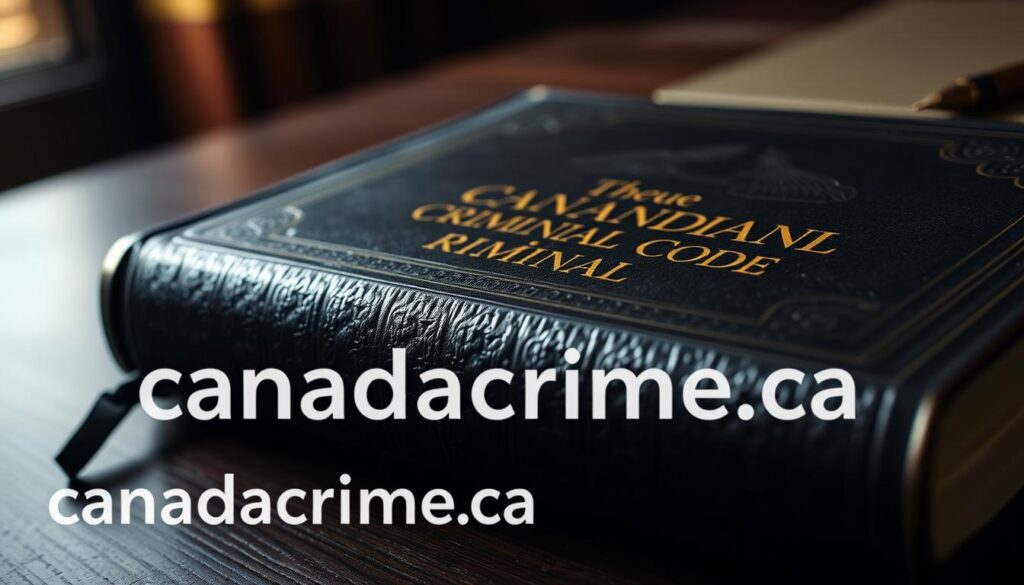
Section 270 of the Criminal Code
Section 270 of the Criminal Code addresses assaulting an officer. It outlines two possible charges for this offense.
- An indictable offense with a maximum imprisonment term of five years, or
- An offense punishable on summary conviction
This dual nature gives prosecutors flexibility in pursuing charges. Courts require proof that the accused knew the victim was a peace officer on duty.
“Everyone commits an offense who assaults a public officer or peace officer engaged in the execution of his duty or a person acting in aid of such an officer.”
Related Offenses in Canadian Law
Several related offenses often accompany charges of assaulting an officer. Obstructing justice is common, as physical confrontations may occur during attempts to stop officers’ duties.
Other related provisions include:
- Section 270.01 – Assault with a weapon or causing bodily harm to a peace officer
- Section 270.02 – Aggravated assault against a peace officer
- Section 270.1 – Disarming a peace officer
- Section 129 – Obstructing a peace officer
These provisions address various levels of confrontation with law enforcement. The charge severity increases based on weapons involvement and extent of injuries.
Recent Legislative Changes
Parliament has made amendments to strengthen protections for peace officers. These changes address concerns about officer safety and deterrence against assaults.
Key legislative developments include:
- Increased maximum penalties for assaults against officers in certain circumstances
- Expanded definitions of “peace officer” to include additional categories of public safety personnel
- Enhanced sentencing provisions that treat assaults against officers as aggravating factors
These amendments show Parliament’s commitment to protecting law enforcers. They reflect the changing nature of law enforcement challenges in Canada.
Obstructing justice charges with assault allegations lead to more severe consequences. This approach aims to protect law enforcement while upholding Canadian criminal justice principles.
Elements of the Offense
Assaulting a peace officer is different from standard assault charges in Canadian law. Prosecutors must prove specific elements to secure a conviction. These elements are crucial to understand if you face such allegations.
Physical Contact Requirements
Physical contact isn’t always needed for an assault charge on a peace officer. Canadian law defines assault in various ways.
- Intentionally applying force to an officer without consent
- Attempting or threatening to apply force when the officer has reasonable grounds to believe you can carry out the threat
- Accosting or impeding an officer while openly wearing or carrying a weapon or imitation
Even minimal contact can count as assault. Pushing, shoving, spitting, or throwing objects at an officer all qualify. Gestures causing fear of harm can also be assault, even without physical contact.
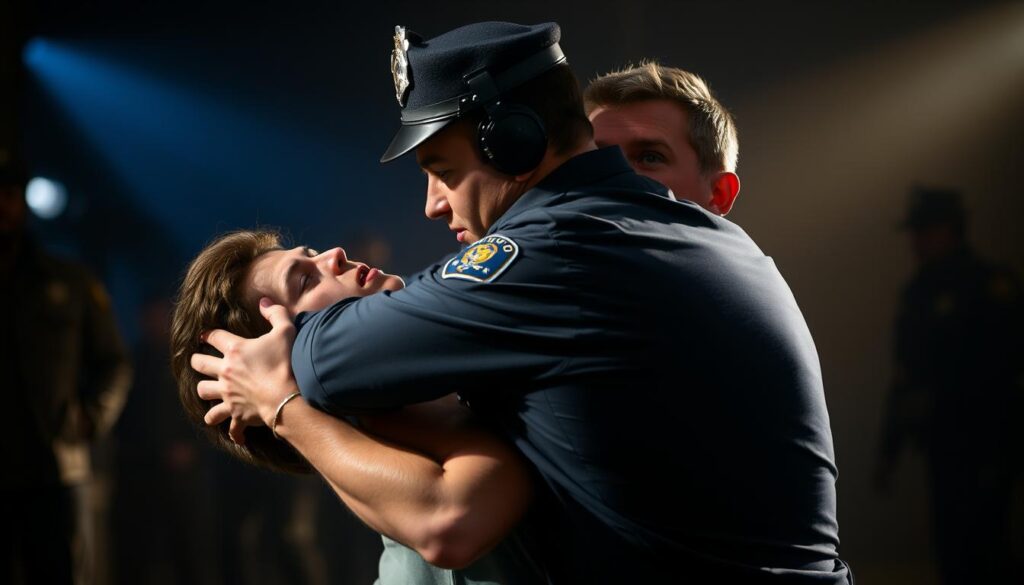
Intent and Knowledge Standards
For a cop assault charge, prosecutors must show you had the required mental state. This means proving you intentionally performed the assault act.
You must have known, or should have known, the person was a peace officer. This is crucial, especially with plainclothes officers or unclear identification.
Courts don’t need proof you meant to assault an officer. They look at whether you deliberately committed assault while knowing the victim’s status.
Officer’s Duty Status Considerations
The law protects officers “engaged in the execution of their duty.” This status affects how assault charges are treated in court.
On-Duty vs. Off-Duty Situations
On-duty officers performing official functions are clearly protected. But complications arise in borderline situations.
On-duty officers are protected even during breaks. Courts say officers remain “in execution of duty” during brief personal activities in working hours.
Off-duty officers intervening in crimes are usually acting officially. Courts say peace officers are “always on duty” when responding to crime, even outside work hours.
| Officer Status | Legal Protection | Required Knowledge | Typical Penalties |
|---|---|---|---|
| Uniformed On-Duty | Full protection | Knowledge presumed | Most severe |
| Plainclothes On-Duty | Full protection | Must prove knowledge | Severe |
| Off-Duty Responding | Protected if executing duty | Must prove identification | Case-dependent |
| Off-Duty Personal | Limited protection | No presumed knowledge | Similar to civilian assault |
Plain Clothes Officers
Cases with plainclothes officers are challenging in assault prosecutions. For enhanced protections, several factors matter.
Officers must identify themselves before or during interaction. This means announcing their status and showing a badge or ID.
Courts check if a reasonable person would know they’re dealing with an officer. Unclear identification may affect conviction for assaulting a peace officer.
The Criminal Code lists different levels of assault against officers. These include simple assault, assault with a weapon, and aggravated assault. Penalties increase with the seriousness of the conduct.
Knowing these elements is vital if you’re charged with assaulting an officer. Your case’s specifics will greatly impact how courts view the allegations against you.
Distinguishing Between Types of Assault Against Peace Officers
The Canadian legal system has different types of assault against peace officers. Each type has its own elements and penalties. Understanding these differences is crucial for those facing such charges.
The Criminal Code sets up a hierarchy of offenses. The severity depends on the conduct and harm caused to the officer. Prosecutors must prove specific elements for each category.

Simple Assault Charges
The basic form of assault against a peace officer involves intentional force without consent. This can include pushing, shoving, or spitting on an officer performing their duties.
Simple assault doesn’t require that the officer sustain injuries. Physical contact that interferes with their duties is enough for charges. These cases usually result in summary conviction proceedings.
Assault with a Weapon or Imitation Weapon
Using or threatening to use a weapon against an officer is a serious offense. Section 270.01 of the Criminal Code addresses this form of violence.
A “weapon” can be any object used to threaten or harm the officer. This includes conventional weapons, everyday items, and even imitation weapons that appear real.
The penalties are more severe, with up to 10 years imprisonment when prosecuted by indictment.
Assault Causing Bodily Harm
Charges escalate when an assault results in bodily harm to a peace officer. “Bodily harm” is any hurt that interferes with health or comfort.
This category falls under Section 270.01 and carries a potential 10-year maximum sentence. Prosecutors must prove both the assault and the resulting harm.
Aggravated Assault Against Officers
The most serious category is aggravated assault against peace officers under Section 270.02. This offense occurs when someone wounds, maims, disfigures, or endangers an officer’s life.
These cases involve severe injuries and carry harsh penalties – up to 14 years imprisonment. Courts treat these offenses with particular gravity.
The evidence requirements become more stringent with each escalating category. Knowing which charge you’re facing is crucial for an effective defense.
Penalties and Sentencing in Canadian Courts
Understanding potential penalties for assaulting a peace officer in Canada is vital. The justice system treats these offenses seriously. It recognizes peace officers’ crucial role in maintaining public safety.

Summary vs. Indictable Prosecution
Assault against a peace officer can be prosecuted in two ways. As a hybrid offense, the Crown chooses the path.
Summary conviction (less serious cases) carries up to two years less a day in jail. It involves a simpler court process with generally lower penalties.
Indictable prosecution (more serious cases) can lead to five years imprisonment for simple assault. Penalties increase for resisting arrest with violence or using weapons.
Typical Sentencing Ranges by Province
Sentencing practices vary across Canada, despite the national Criminal Code. Understanding these differences helps set realistic case expectations.
| Province | Simple Assault (Summary) | Assault with Weapon | Aggravated Assault |
|---|---|---|---|
| Ontario | Probation – 90 days | 90 days – 18 months | 2 – 10 years |
| British Columbia | Probation – 6 months | 6 months – 2 years | 3 – 12 years |
| Alberta | 30 days – 6 months | 6 months – 2 years | 2 – 8 years |
| Quebec | Probation – 4 months | 4 months – 18 months | 2 – 10 years |
Aggravating Factors Considered by Judges
Several factors can increase your sentence if convicted of assaulting a peace officer. Judges focus on how peace officer safety was affected during the incident.
Premeditated attacks are viewed more severely than spontaneous reactions. Using weapons or causing serious injuries will substantially increase penalties.
Your prior criminal record, especially for similar offenses, heavily influences sentencing decisions.
“Assaults on peace officers strike at the foundation of our justice system and the safety of our communities. The courts must respond with sentences that reflect both denunciation and deterrence.”
Incidents during public disturbances or riots typically receive harsher sentences. Assaults to prevent lawful arrest are treated with particular severity.
Recent Canadian Case Examples
In R v. Desautel (2021), a defendant got 18 months for punching an officer during a traffic stop. The court emphasized protecting officers performing routine duties.
In R v. Mikhail (2020), using a knife while resisting arrest resulted in a 4-year sentence. The premeditated nature and weapon use significantly impacted sentencing.
In R v. Johnson (2022), a first-time offender received a conditional sentence for pushing an officer. The court considered mitigating factors like mental state and immediate remorse.
Legal Defenses for Assault Against a Peace Officer Charges
Facing police assault charges requires understanding specific legal defenses in Canadian law. Your defense strategy must address the offense elements and incident circumstances. Canadian law recognizes several valid defenses depending on your case details.
Mistaken Identity Defense
This defense shows you didn’t know the person was a peace officer. It’s useful for plainclothes officers or unclear identification situations.
You must prove the officer didn’t identify themselves properly. Courts examine if the officer wore a uniform, showed a badge, or verbally identified themselves.
Self-Defense Claims
Canadian law allows self-defense, even against peace officers in certain situations. Section 34 of the Criminal Code outlines lawful self-defense parameters.
- A reasonable belief that force is being used against you
- A defensive purpose behind your actions
- Actions that are reasonable under the circumstances
Courts evaluate if your response matched the perceived threat. Self-defense claims against peace officers face heightened scrutiny. They remain valid when officers use excessive force.
Unlawful Arrest Situations
You may have a defense if an officer arrests you without proper grounds. However, citizens generally can’t resist arrest, even if they think it’s unlawful.
Unlawful arrests are usually addressed through legal channels after the fact. This defense needs careful handling and proof the arrest lacked legal authority.

Excessive Force by Officer
You may have defense grounds if an officer uses unreasonable force. Section 25 of the Criminal Code limits protection for officers using excessive force.
You’ll need to show the officer’s actions exceeded what the situation required. This often needs witness testimony, medical evidence, or video documentation.
Documenting Police Misconduct
If you suspect excessive force, document the incident. Take injury photos, get medical records, and collect witness contact information.
Try to obtain surveillance footage or police body camera recordings through legal channels. This evidence can be very convincing in court.
Charter Rights Violations
The Canadian Charter of Rights and Freedoms offers important protections. Section 8 guards against unreasonable search and seizure. Section 9 protects against arbitrary detention.
Charter rights violations may support your defense or exclude certain evidence. Your lawyer can file a Charter application to address these violations in court.
Each defense needs careful consideration of your case facts and legal principles. Consulting with a lawyer experienced in law enforcement confrontation cases is essential. They can determine which defenses best fit your situation.
What to Do If You’re Charged with Assaulting a Peace Officer
Being charged with assaulting a peace officer is a serious matter in Canada. Your actions after the incident can greatly impact your defense options. Knowing what to do next is crucial for your legal journey.
Immediate Steps After Being Charged
Exercise your right to remain silent. Only provide basic identifying information. Avoid discussing the incident with anyone except your lawyer.
Focus on securing your release from custody. Review bail conditions carefully before agreeing. Document everything you remember about the incident as soon as possible.
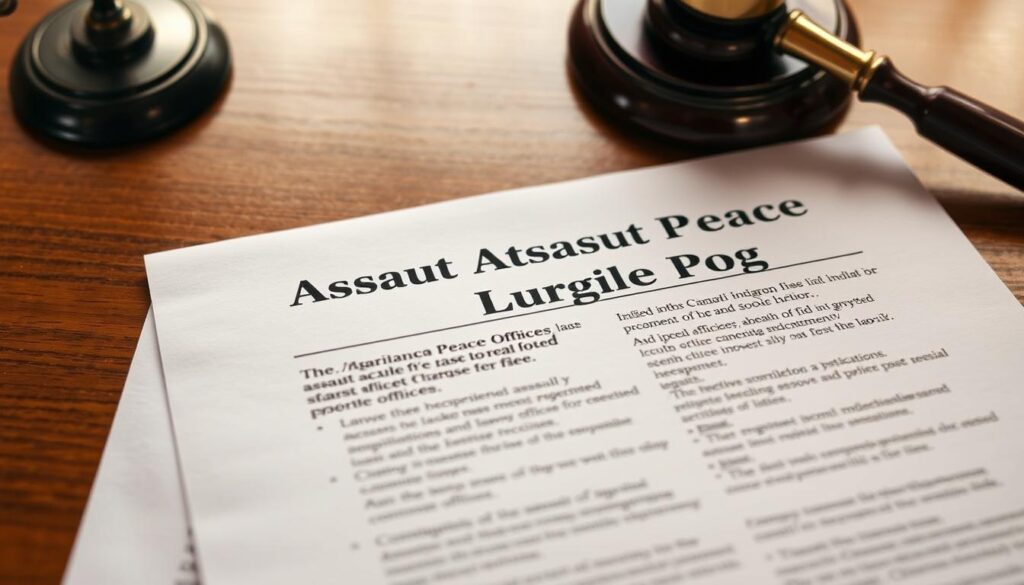
Finding Appropriate Legal Representation
Seek a lawyer experienced in defending against assaulting an officer charges. They should understand the unique aspects of these cases.
Ask potential lawyers about their experience and success rate with similar cases. Discuss their familiarity with local courts and prosecutors. Clarify fee structures and ensure they can dedicate enough time to your case.
Gathering Evidence and Witnesses
Collect evidence quickly. Secure video footage from cameras and identify potential witnesses. Get their contact information.
Document any injuries you sustained with photos and medical reports. Keep any physical evidence related to the encounter.
Understanding Your Rights During the Process
The Canadian Charter of Rights and Freedoms protects you throughout the legal process. You have the right to know the charges against you.
You can’t be forced to testify against yourself. You’re entitled to reasonable bail unless there are compelling reasons for detention.
If police violated your rights, it could help your defense. Work closely with your lawyer to meet all requirements and build a strong defense.
Recent Trends in Assault Against a Peace Officer Cases in Canada
Cop assault cases in Canada show complex patterns across provinces. Recent years have seen changes in prosecution and public perception. These trends offer context for those facing charges or interested in legal developments.
Statistical Data Across Provinces
Statistics Canada reveals varying frequencies of assault against peace officer charges by region. Ontario and British Columbia report the highest numbers. Atlantic provinces show lower rates per capita.
Conviction rates differ regionally too. In 2022, Alberta courts convicted 68% of individuals charged with battery on a police officer. Quebec’s conviction rate was 54%. These differences reflect varied prosecution approaches and judicial attitudes.
| Province | Annual Cases (2022) | Conviction Rate | Average Sentence |
|---|---|---|---|
| Ontario | 1,245 | 62% | 8 months |
| British Columbia | 876 | 59% | 6 months |
| Alberta | 742 | 68% | 10 months |
| Quebec | 912 | 54% | 5 months |
Impact of Body Cameras and Video Evidence
Body-worn cameras have changed how cop assault cases are handled. In areas with camera use, clear case resolutions have increased by 23%.
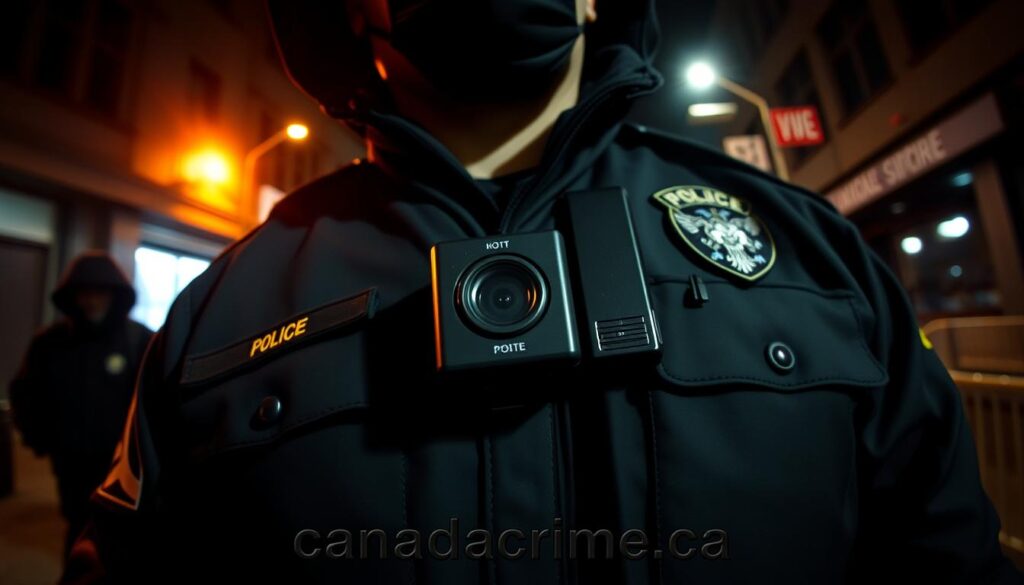
Video evidence is now crucial in these cases. Defense attorneys and prosecutors rely on footage to support their arguments. This often leads to more accurate outcomes.
The advent of body cameras has fundamentally changed the dynamics of assault against peace officer cases. What was once a matter of competing testimonies has evolved into evidence-based proceedings that benefit both officers and citizens.
Provincial Variations in Prosecution
Case handling varies across Canada. British Columbia has special courts for law enforcement conflicts. Manitoba focuses on diversion programs for first-time offenders.
Ontario’s Crown attorneys usually pursue more aggressive prosecution strategies. This differs from their Maritime province counterparts. These regional differences can greatly impact case outcomes and sentencing.
Public Perception and Media Coverage
High-profile police misconduct incidents have shaped public views on assault against peace officer charges. Media coverage now often examines the context of confrontations.
Social media has amplified public discussions about these incidents. This sometimes creates pressure on the justice system. Cases with significant media attention often face greater scrutiny.
Both the facts and public context of your case can influence its progress. The Canadian justice system considers these factors in handling such cases.
Conclusion
An Assault Against a Peace Officer charge in Canada can change your life forever. The Criminal Code treats these offenses seriously. This reflects society’s need to protect law enforcement officers.
Knowing your rights helps prevent situations that could lead to criminal charges. High-stress encounters can blur the line between lawful resistance and criminal conduct. Your self-protection actions might be seen as resisting arrest under Canadian law.
Penalties for these offenses range from fines to long prison terms. Courts consider factors like officer injuries and your prior record when deciding sentences. The use of weapons also affects the severity of punishment.
If charged, get a qualified lawyer right away. They can help with defenses like mistaken identity or self-defense claims. They may also challenge the lawfulness of an arrest.
Canadian law balances officer safety with public accountability. This balance keeps changing as new technologies like body cameras provide fresh evidence.
Peace officers do crucial work, often in dangerous situations. You still have important legal rights during any interaction. This knowledge helps create safe, respectful encounters for both officers and citizens.

